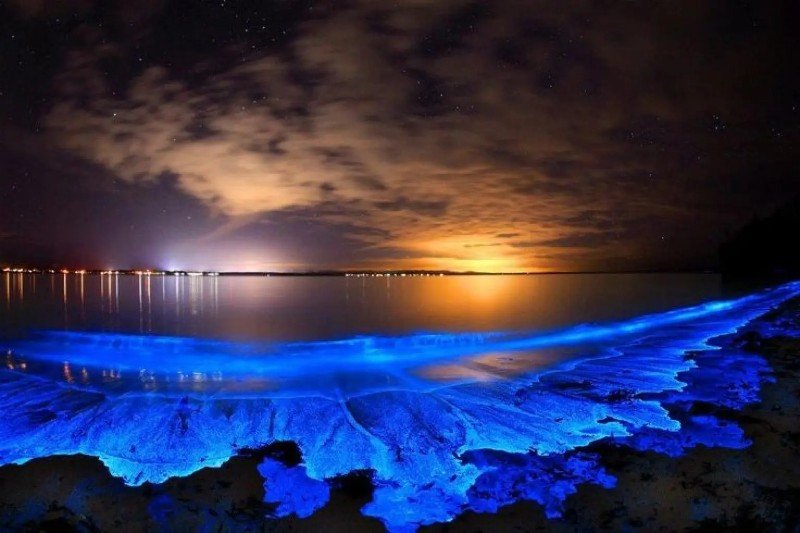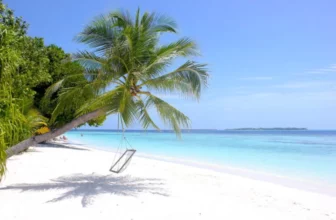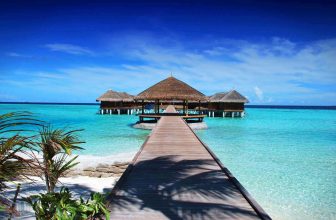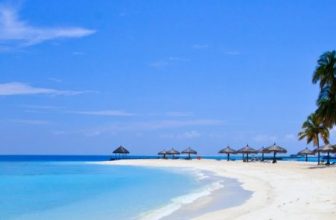The Maldives is known for its breathtaking beaches: warm white sand, waves that ebb and flow rhythmically and blue lagoons. This tropical nation consists of 26 ring-shaped atolls, which are made up of more than 1,000 coral islands. When looking at what the Maldives has to offer, we’re not surprised it’s a top holiday or honeymoon destination.
The glowing beach, known for its world famous sea of stars, is located in the Vaadhoo Island, one of the islands of Raa Atoll in the Maldives.
1. What Makes The Beach Bioluminescent?
A natural phenomenon occurs in the Maldives, which turns the beach into a glowing sea of stars – the beach is actually bioluminescent, but is commonly referred to as a glowing beach. This phenomenon is caused by bioluminescent organisms.
Initially this magical effect was said to be caused by bioluminescent plankton, but Cornell biology professor James Morin told Huffington Post that the organisms creating the glow in the Maldives are ‘ostracod crustaceans’. Referring to the organisms as phytoplankton is a common misconception.
Why is it called the glowing beach?
The bioluminescent organisms – ostracod crustaceans – emit light that sets the beach ablaze like stars. This results in the phenomenon of the glowing beach.
An explosion of bioluminescent organisms makes the beach look like it’s been hit by blue radioactive fairy dust. When the waves wash ashore, the sand also starts to glow. This glowing beach really is a sight to behold; hearing someone describe it or seeing pictures of it, doesn’t do this place justice.
Although it looks like a chemical spill, it is perfectly safe to be in the water during bioluminescence.
The phytoplankton emit light for no more than a second, while ostracods make the magic last for seconds to even a minute or longer.
What causes the light emissions?
Ostracods emit light when something comes into the water,while phytoplankton emit light from their cells when they are stressed or there’s an unsettling in the water. Seeing as this happens for no more than a second, the phytoplankton emit quite a bit of light because they are easily unsettled: a wave, a kayak or even a hand stirring the water will do the trick. Informally, it’s called the ‘firefly effect’.
2. Why Does It Happen In The Maldives?
Bioluminescent organisms are often found in warm coastal waters. Because the Maldives is located in the Indian Ocean – the warmest ocean in the world – this is the perfect condition for a bioluminescent beach.
Does it only happen in the Maldives?
It would add to the wonder of the glowing beach if it only occurred in one place, but Mother Nature had other plans.
Bioluminescent organisms are not only found in the Maldives, and the best part about these other countries that also have glowing beaches is that they all make for amazing holiday destinations.
Bali, Jamaica, Puerto Rico and Japan are a few. Here’s a list of 12 stunning places to see bioluminescence. The glowing beaches found across these 12 stunning places have different organisms that emit light and different reasons why they emit light.
‘Firefly squid’ is the reason why Toyama Bay, a bay near the Japan Sea, is bioluminescent. When it comes to luminescence, it seems Japan has more to offer:
Gyokusendo Caves in Okinawa, Japan, is a well-known cave because of what lurks inside: a 3 mile long cave, consisting of limestones with stalactites hanging from the walls.The crystal clear pool is famous for its glowing water that is home to some colourful fish. Some of the spots in the cave are safe for diving.
India, too, has glowing forests and beaches.
3. When Is The Best Time To See The ‘Glowing Beach’ in the Maldives?
The best time to get a witness the glowing beach in the Maldives is mid-summer through to winter. However, there are no guarantees that you will see the beach come alight. Consider yourself lucky, if you see something like this.
The glowing beach is stunning, and it’s crazy to think that something so fascinating can be called a natural phenomenon. Or that it’s even real.
Another great reason to visit the Maldives
Seeing as the Maldives is a tropical nation, a lot of its activities consist of spending time in water. But with the impressive waters and aquatic life, we’re not complaining.
Manta point is a popular attraction because it’s home to the majestic manta rays. The elusive animals will make an appearance every now and then: they’re great for business because people keep coming back to see them or get a closer look (if you were lucky to spot them the first time round).
The private half day local experience of Malé is a great way to walk in the shoes of a Maldivian.
Malé, the capital of the Maldives is known for its mosques, cultural heritage and vibrant buildings.The Malé fish market offers an authentic experience; fishermen expertly filleting and cleaning fish. Fridays are sacred days, so do keep this in mind as businesses will close for mosque.
When it comes to the bioluminescent beach of the Maldives, this is where Mother Nature shows off. You could always camp out in the Maldives to witness the sometimes elusive, glowing beach in the Maldives.
There are so many adventures to be had: snorkeling, whale watching, boat trips and boat tours, scuba diving or witnessing the way of life for the Maldivian citizens, and sights to be seen: the gorgeous sacred mosques that are architectural masterpieces.Seeing the glowing beach is just another great reason to visit the Maldives.







